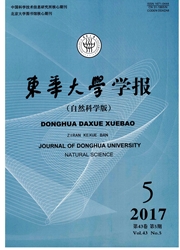

 中文摘要:
中文摘要:
采用射频等离子体化学气相沉积(RF-PECVD)技术,以SiH4和Ar的混合气体为源气体,在石英玻璃衬底上制备了硅基发光薄膜.利用场发射扫描电子显微镜(FESEM)、X射线衍射(XRD)、透射电子显微镜(TEM)和傅里叶红外光谱(FTIR)对薄膜的形貌、结构和性能进行了表征,并利用发射光谱(OES)对薄膜等离子体生长过程进行了分析.研究结果表明,随着射频功率的增加,等离子体发射光谱中Hβ谱线强度激增,薄膜的红外光谱中Si—O键在1095cm-1处振动吸收峰强度减小,Si—Si键在613cm-1处特征吸收峰强度增加,说明射频功率增加加剧了硅烷的裂解与氧化硅的还原,提高了薄膜结晶度和纳米晶粒的融合度,并降低了沉积薄膜的表面粗糙度.
 英文摘要:
英文摘要:
Silicon-based luminescent thin films were deposited on quartz glass substrate by radio frequency plasma enhanced chemical vapor deposition (RF-PECVD) technique with the mixture of SiH4 and Ar as reaction gases.Field emission scanning electron microscope (FESEM),X-ray diffraction (XRD),transmission electron microscope (TEM) and Fourier infrared spectra (FTIR) were used to investigate the surface morphology,structure and property of the films.And the reactive plasma species were analyzed by optical emission spectrum (OES).It was shown that the intensity of Hβ in plasma increased,the infrared absorption intensity of Si—O bond at 1 095 cm-1 decreased and Si—Si bond at 613 cm-1 increased with the increasing of the radio frequency power of the plasma.So it was reasonably believed that the raised radio frequency power would promote the dissociation of silane and reduction of the deposited silicon oxide,which would result in increasing of the film crystallinity,nanocrystal fusion and decreasing of film surface roughness.
 同期刊论文项目
同期刊论文项目
 同项目期刊论文
同项目期刊论文
 Characteristics of Coaxial Dielectric Barrier Discharge at an Atmospheric Pressure with a Swirling G
Characteristics of Coaxial Dielectric Barrier Discharge at an Atmospheric Pressure with a Swirling G Effects of air dielectric barrier discharge plasma treatment time on surface properties of PBO fiber
Effects of air dielectric barrier discharge plasma treatment time on surface properties of PBO fiber Time-Resolved Images of the Decay of the Gas Channel Induced by Pulsed Positive Streamer Discharge i
Time-Resolved Images of the Decay of the Gas Channel Induced by Pulsed Positive Streamer Discharge i Electrical and Optical Characterization of DBD and Its Application to Plasma Treatment of PET Fibers
Electrical and Optical Characterization of DBD and Its Application to Plasma Treatment of PET Fibers Advanced high-pressure plasma diagnostics with hairpin resonator probe surrounded by film and sheath
Advanced high-pressure plasma diagnostics with hairpin resonator probe surrounded by film and sheath Surface modification of polyethylene terephthalate (PET) fiber by roll-to-roll treatment in atmosphe
Surface modification of polyethylene terephthalate (PET) fiber by roll-to-roll treatment in atmosphe Effect of thermoplastic coating on interfacial adhesion of oxygen-plasma-pretreated PBO/PPESK compos
Effect of thermoplastic coating on interfacial adhesion of oxygen-plasma-pretreated PBO/PPESK compos Preparation and Characterization of Collagen-Based Composite Conduit for Peripheral Nerve Regenerati
Preparation and Characterization of Collagen-Based Composite Conduit for Peripheral Nerve Regenerati Excitation frequency dependent mode manipulation in radio-frequency atmospheric argon glow discharge
Excitation frequency dependent mode manipulation in radio-frequency atmospheric argon glow discharge Synthesis of intrinsic fluorescent polypyrrole nanoparticles by atmospheric pressure plasma polymeri
Synthesis of intrinsic fluorescent polypyrrole nanoparticles by atmospheric pressure plasma polymeri Influences of impedance matching network on pulse-modulated radio frequency atmospheric pressure glo
Influences of impedance matching network on pulse-modulated radio frequency atmospheric pressure glo The extremely narrow hysteresis width of phase transition in nanocrystalline VO2 thin films with the
The extremely narrow hysteresis width of phase transition in nanocrystalline VO2 thin films with the 期刊信息
期刊信息
